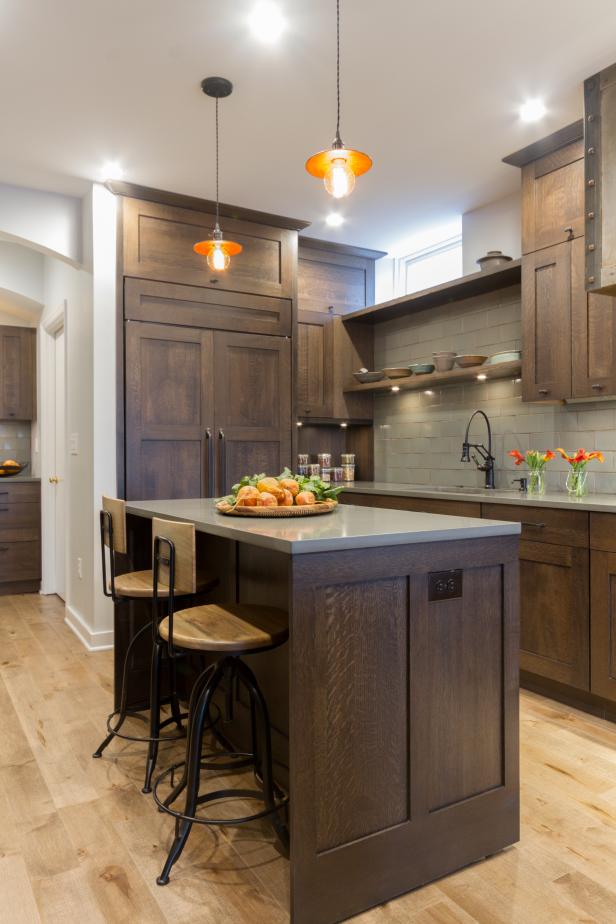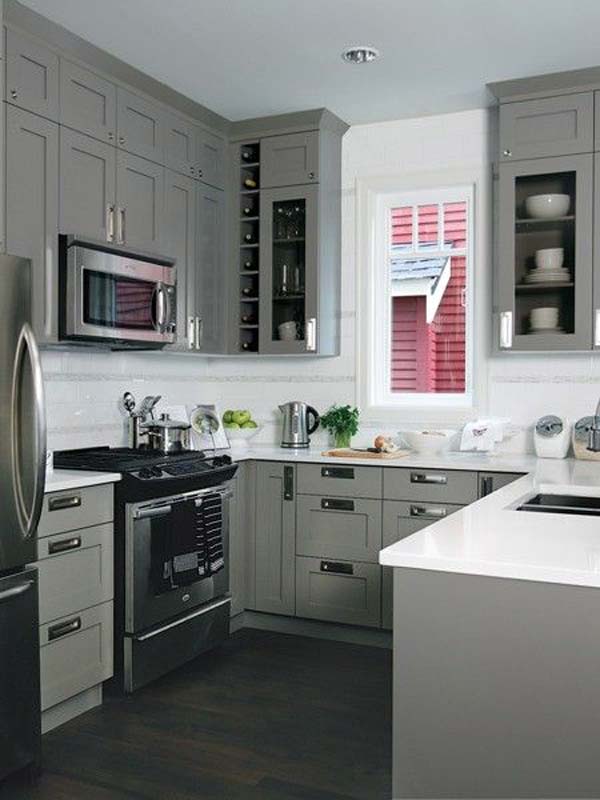Tiny home kitchen cabinets play a crucial role in making the most of limited space while maintaining functionality and style. In tiny homes, every inch counts, so choosing the right cabinets can enhance the usability of the kitchen, provide ample storage, and even influence the overall aesthetic. When designing or selecting kitchen cabinets for a tiny home, it’s essential to consider factors like cabinet layout, material choices, storage innovations, and visual impact. Well-planned cabinetry can make a tiny kitchen feel open, organized, and efficient, transforming it from a cramped space to a functional cooking area.
Maximizing vertical space is a smart approach for tiny home kitchen cabinets. By extending cabinets from the floor to the ceiling, you can create additional storage that doesn’t eat into precious floor space. Taller cabinets can hold items that are not frequently used but are still necessary, like seasonal cookware or bulk pantry items. Some designs include a combination of closed cabinets and open shelves in the upper portion, offering a balance between accessible storage and display space. Adding a rolling step stool can make it easier to access those upper shelves without taking up much space.

Another efficient solution is to opt for pull-out cabinets and drawers. Standard cabinets can be challenging to use fully, especially in tight spaces. Pull-out cabinets or drawers allow for easy access to items stored in the back, maximizing storage space and reducing the need to bend or reach. Pull-out pantry cabinets are particularly popular in tiny home kitchens because they can store a surprising amount of goods in a narrow space. Pull-out options for trash and recycling can also help keep the kitchen organized while saving floor space.
Corner cabinets are often underutilized in standard kitchens, but in tiny homes, they can be transformed into highly efficient storage areas. By using corner cabinet solutions like Lazy Susans or pull-out trays, you can make the most of every corner without losing items to the dark recesses of traditional cabinetry. Diagonal corner cabinets or blind corner solutions provide an accessible and spacious option for storage, utilizing every available inch of cabinetry space and keeping the kitchen organized.

Choosing light-colored cabinets can help make a tiny kitchen feel larger and more open. White, beige, or light gray cabinetry reflects light, creating a bright and airy feel, which is essential in a small space. Glass cabinet doors can further enhance this effect by visually expanding the area and providing an open feel. Open shelving can also contribute to a more spacious look, though it requires organized and minimal storage habits to avoid clutter. Combining glass doors or open shelving with closed cabinets is an excellent way to achieve a balance between style and practicality.
Incorporating multipurpose cabinets is another key consideration in tiny home kitchen design. Multipurpose cabinets can include features like fold-out cutting boards, built-in spice racks, or even hidden compartments for small appliances. These designs save counter space and keep frequently used items within easy reach. For instance, a pull-out cutting board can double as extra counter space, while cabinets with built-in dividers keep cooking utensils organized without taking up drawer space. This approach ensures that all essentials are within arm’s reach without overwhelming the kitchen’s layout.

Compact appliances can fit seamlessly into tiny home kitchen cabinets, creating a more integrated and uncluttered appearance. Under-counter appliances, such as mini-fridges, microwaves, and dishwashers, help to maintain countertop space and prevent the kitchen from feeling overcrowded. Some designs even integrate appliances like microwaves or coffee makers directly into the cabinetry, freeing up valuable space and allowing for a cohesive, streamlined look. Built-in options make the kitchen feel like one continuous unit, adding to the space-saving effect.
To further optimize storage, consider cabinets with adjustable shelving. Adjustable shelving allows you to customize the space inside each cabinet based on your specific needs, making it ideal for storing items of varying sizes. For example, taller shelves can store items like cereal boxes or blenders, while shorter shelves can hold plates, cups, or spices. This flexibility ensures that no space goes to waste and that everything has a dedicated spot. Adjustable shelving also allows for future adaptability, which can be beneficial as storage needs change over time.
Drawer organizers and dividers are essential for small kitchens. These accessories help categorize kitchen items and keep them neatly arranged, reducing clutter and making it easier to find what you need. Adjustable dividers work well for storing utensils, lids, or cutting boards, while inserts specifically designed for spices, silverware, or knives maximize drawer functionality. By keeping drawers organized, you can avoid overcrowding the limited cabinet space, making the kitchen feel more spacious and manageable.

Hooks and magnetic strips are another clever addition to tiny home kitchen cabinets. Installing hooks on the inside of cabinet doors can provide extra space for items like measuring spoons, small pots, or hand towels, while magnetic strips can hold knives or metal utensils. These solutions take advantage of vertical space and keep frequently used items accessible without using drawer or counter space. Magnetic strips or hooks can be installed with minimal effort, making them an easy way to improve storage efficiency in a small kitchen.
Foldable or retractable cabinets can provide flexibility in a tiny home kitchen. These cabinets offer a compact storage solution that can be expanded or contracted based on your needs. For instance, a foldable countertop that tucks away when not in use can serve as both a dining table and an additional workspace. Pull-down or retractable shelves can also provide extra storage without taking up valuable space when not in use. This adaptable approach is especially valuable in tiny homes, where maximizing functionality without clutter is key.
High-quality cabinet hardware can make a surprising difference in the usability of tiny home kitchen cabinets. Smooth-gliding hinges, soft-close drawers, and sturdy handles enhance the functionality and feel of the kitchen. For instance, soft-close drawers prevent noise and reduce wear and tear, while high-quality handles are more comfortable to use in a small space where cabinets are frequently opened and closed. Opting for compact handles or hidden hardware can further contribute to a streamlined look that fits well in tiny kitchens.

Open shelves and cabinet cubbies provide an alternative to traditional cabinetry, creating visual interest and flexibility. Cubbies can hold items like baskets, small jars, or decorative pieces, while open shelves allow easy access to everyday items. These solutions can also be less costly than closed cabinetry, and they make it easy to locate frequently used items. The only caveat is to maintain organization and keep items to a minimum to avoid a cluttered look.
Custom cabinets are often a worthwhile investment in tiny home kitchens. Because of the limited space, custom cabinets can be tailored to fit the exact dimensions and requirements of your kitchen, maximizing every inch. Custom solutions allow for unique features, such as pull-out pantries, foldable tables, or appliance garages, which are challenging to achieve with standard cabinets. While custom cabinetry can be more expensive, the benefits in terms of space optimization and design cohesion often outweigh the costs in a small kitchen setting.
Sustainability can also be a priority when selecting cabinets for a tiny home kitchen. Choosing eco-friendly materials, such as bamboo or recycled wood, helps to reduce the environmental impact of your kitchen design. Many cabinet manufacturers offer options that use low-VOC finishes and sustainable materials, making it easy to create an environmentally conscious kitchen. Additionally, choosing durable materials for cabinets ensures that they will last longer, reducing the need for replacement and contributing to a more sustainable living space.
In a tiny home, kitchen cabinets can set the tone for the entire space. Since the kitchen is often visible from other parts of the home, the cabinetry style and color play a significant role in creating a cohesive look. Choosing a cabinet design that complements the rest of the home helps create a sense of continuity and spaciousness. Whether you prefer a modern, minimalist look with sleek finishes or a cozy, rustic aesthetic with warm wood tones, the cabinet style can enhance the overall ambiance of a tiny home.

Common Mistakes to Avoid
Overloading Open Shelving: Open shelves can create a feeling of spaciousness, but too many items can lead to a cluttered look. Limit open shelving to essentials or decorative pieces to maintain a streamlined appearance.
Ignoring Cabinet Height: Not extending cabinets to the ceiling wastes valuable vertical space. Full-height cabinets provide extra storage for less-used items, reducing clutter in lower areas.
Using Dark Cabinet Colors: Dark cabinets can make a tiny kitchen feel cramped. Opting for lighter colors helps to open up the space and create a more inviting atmosphere.
Forgetting About Drawer Dividers: Dividers maximize drawer functionality, keeping small kitchens organized. Without them, drawers can become messy, leading to wasted space and difficulty finding items.
Skipping Quality Hardware: High-quality hinges and glides make a difference in tiny kitchens where cabinets are frequently used. Poor hardware can wear out quickly, reducing the cabinets’ usability and lifespan.
Neglecting Vertical Storage Solutions: Failing to use hooks, magnetic strips, or door racks overlooks valuable storage opportunities that can free up counter and drawer space.

How can I maximize storage in my tiny home kitchen cabinets?
Utilize vertical space with full-height cabinets, adjustable shelving, and pull-out options. Accessories like hooks, magnetic strips, and dividers can also help maximize every inch, keeping your kitchen organized and functional.
Are custom cabinets worth the investment for a tiny kitchen?
Yes, custom cabinets are often worth it as they can be designed to fit the exact dimensions of your kitchen, allowing for unique solutions like fold-out tables and pull-out pantries that maximize space.
What cabinet colors work best in a tiny home kitchen?
Light colors like white, beige, or soft gray are ideal for tiny kitchens, as they reflect light and make the space feel more open. Glass doors or open shelving can also help create an airy appearance.
How can I organize my kitchen cabinets to avoid clutter?
Use drawer dividers, pull-out trays, and cabinet organizers to keep items neatly arranged. Designate specific areas for each type of item, and keep countertops clear to prevent clutter buildup.
What types of materials are best for tiny home kitchen cabinets?
Durable, lightweight materials like plywood or eco-friendly options like bamboo work well in tiny homes. Low-VOC finishes and sustainable wood options are ideal for an eco-friendly kitchen design.
Are open shelves a good idea in a tiny home kitchen?
Open shelves can be useful if you keep them organized and minimal. They add visual space and easy access to frequently used items but require consistent organization to avoid a cluttered look.

Related Posts:
- Kitchen Cabinets Boise Idaho
- Wood Degreaser Kitchen Cabinets
- How To Remove Oil Stains From Kitchen Cabinets
- Tambour Door Kitchen Cabinet
- Kitchen Cabinet Basics
- How To Refinish Formica Kitchen Cabinets
- Kitchen With White Cabinets And Stainless Steel Appliances
- Oak To White Kitchen Cabinets
- Chan Kitchen Cabinet
- High Gloss Lacquer Finish Kitchen Cabinets